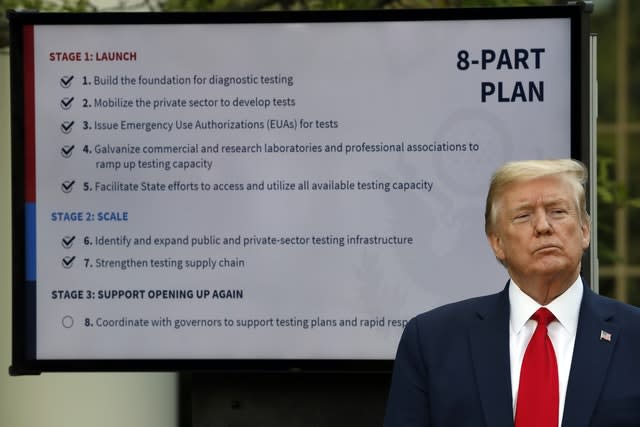Coronavirus testing doubts remain despite Trump’s assurances and new guidelines
The White House has released new guidelines aimed at answering criticism that America’s coronavirus testing has been too slow.
But doubts remain from public health experts that new testing targets from US President Donald Trump’s administration are sufficient.
The administration unveiled a “blueprint” for states to scale up their testing in the coming week – a tacit admission, despite public statements to the contrary, that testing capacity and availability over the past two months have been lacking.
The new testing targets would ensure states had enough Covid-19 tests available to sample at least 2.6% of their populations each month – a figure already met by a majority of states. The White House said areas that have been harder hit by the virus would be able to test at double that rate, or higher.
The testing issue has dogged the administration for months. Mr Trump told reporters on March 6 during a visit to the Centres for Disease Control and Prevention (CDC) in Atlanta that “anybody that wants a test can get a test”, but the reality has proved to be vastly different.
The initial Covid-19 test developed by the CDC was contaminated, and early kits operated only on platforms able to perform a small number of tests per day. While the rate of testing increased as tests developed for higher-capacity platforms, they were still limited by shortages of supplies, from nasal swabs to the reagents used to process the samples.
Thanks to incredible cooperation between government and the private sector, we've taken the lead in testing worldwide. pic.twitter.com/ntTF6moHPa
— The White House (@WhiteHouse) April 27, 2020
Administration officials maintain that the limiting factor now is the availability of samples from people who have been tested – either because guidelines on who could be tested are too stringent or because there are not enough health workers able to take nasal swab samples from them.
The CDC has moved to address one of those concerns, expanding the list of people to be prioritised for virus testing to include those who show no symptoms but are in high-risk settings like nursing homes. And Mr Trump met with leaders of businesses including CVS, Walmart and Kroger, who said they were working to expand access to tests across the country.
“Testing is not going to be a problem at all,” Mr Trump said later.
However, many of the administration’s past pledges and goals on testing have not been met.

Jeremy Konyndyk, a disaster preparedness expert who helped lead the Obama administration response to Ebola, said the administration’s testing plans are well short of what is needed.
Researchers at Harvard University have estimated the country needs to be testing a minimum of 500,000 people per day, and possibly many more. Mr Konyndyk said the aim should be 2 million to 3 million per day. Mr Trump said the current total, up sharply in recent days, is over 200,000 per day.
Mr Konyndyk said: “Over the past month, we’ve doubled or if you want to be really generous tripled the testing capacity in this country. We need to take where we are now and expand it tenfold.”
The testing blueprint for states provides details missing from the administration’s guidelines for them to return to normal operations, which were released more than a week ago. It includes a focus on surveillance testing as well as “rapid response” programmes to isolate those who test positive and identify those with whom they had come in contact.
